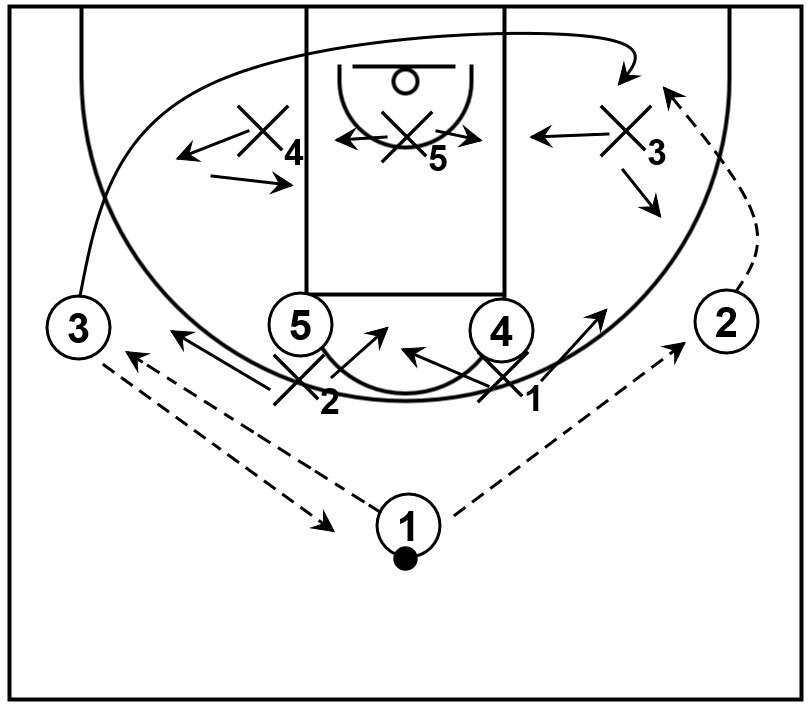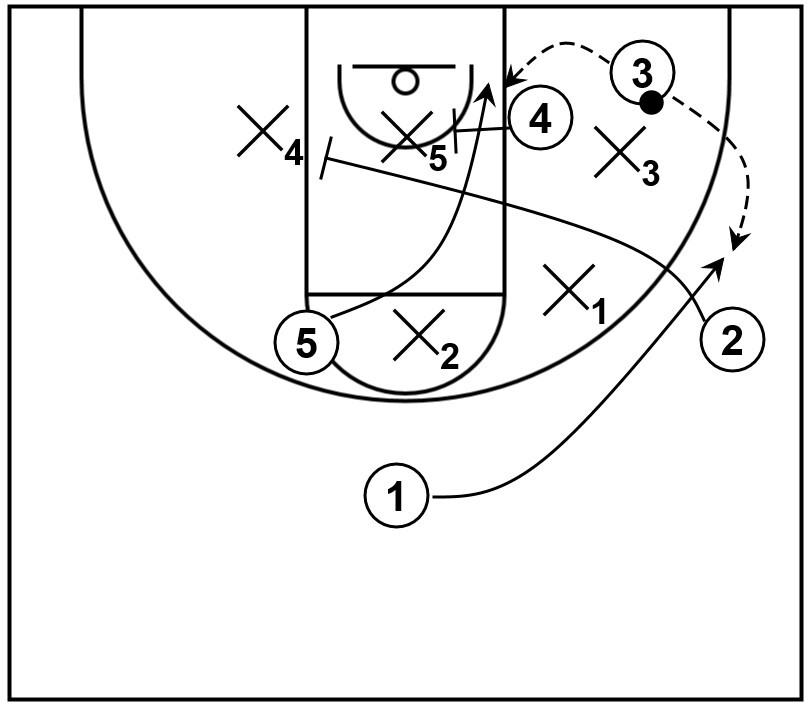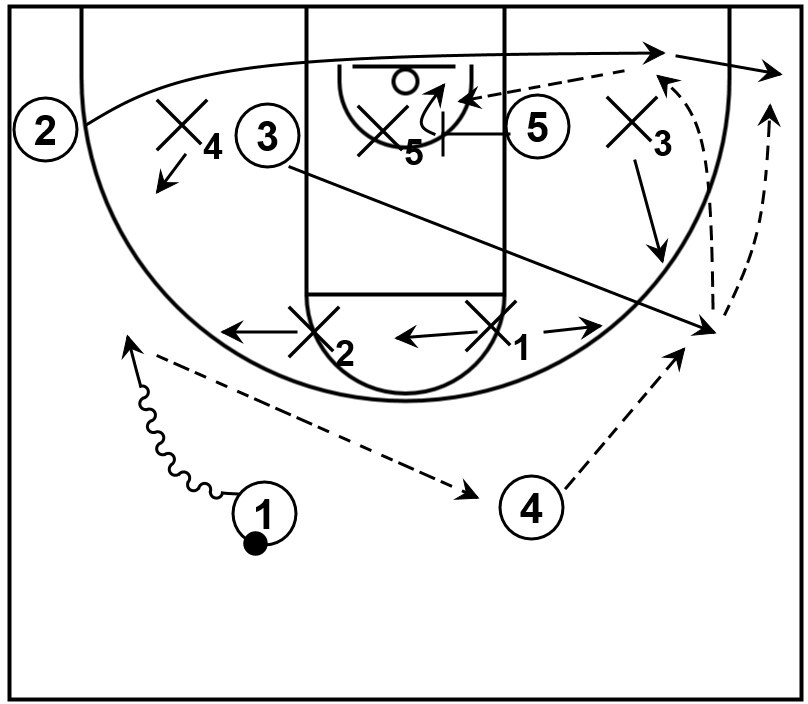Basic definition of 2-3 zone offense
The 2-3 zone offense consists of plays, strategies, and actions that are designed to create scoring opportunities against the 2-3 zone defense.
Basketball Plays
This section features 2-3 zone offense basketball plays with various scoring options. It is also very likely that more plays will be added over time.
Additionally, each of the offensive and/or defensive players on any diagrams below are generally represented by the standard basketball positions, unless otherwise noted.
In essence, 1 and X1 are the offensive and defensive point guards, respectively.
2 and X2 are the offensive and defensive shooting guards, respectively.
3 and X3 are the offensive and defensive small forwards, respectively.
4 and X4 are the offensive and defensive power forwards, respectively.
5 and X5 represent the offensive and defensive center positions, respectively.
1-4 High
Part 1: Ball Reversal and through cut

This is an example of a 2-3 zone offense play primarily featuring ball reversal and a through cut towards the opposite side of the floor.
In terms of the initial setup, it is a 1-4 high set with offensive players in the following spots on the court: 1 is at the top in possession of the ball, represented by the black dot; 2 and 3 occupy the right side and left side wing areas respectively; 4 and 5 fill the right side and left side high post elbow areas respectively.
To begin, 3 receives the ball from 1, represented by the dotted arrow. That pass also influences the zone defenders to move from their original locations as well.
Immediately afterwards, 1 receives the ball again and quickly swings it to the other side with 2 as the recipient. This shifts the zone defenders in that direction as well.
Moreover, as that ball reversal occurs, 3 cuts through to the right side short corner area that is between the deep corner behind the three-point line and the right side low post area, generally behind the zone defenders, especially X3.
Once in place at the short corner, 3 could receive the ball from 2, preferably by way of a bounce pass that is thrown at an angle. From there, 3 could take the mid-range jump shot if that is feasible.
It should be mentioned as well in regards to the ball reversal is that if 2 just happens to be open because X3 doesn’t slide upwards to contest and/or because X1 is not able to closeout quickly enough, then 2 could take the three-point jump shot if that is open.
Part 2: Cross screens and dive cut

Continuing on, 2 could cut down into the lane to set a cross screen on X4. Furthermore, around that same time, 4 can set a cross screen on X5.
Additionally, while those screening actions occur, 5 dive cuts into the open gap behind 4, receive the ball from 3, and score by way of a layup.
Alternatively, if X1 and/or X3 are paying too much attention to the screening actions while 3 still retains possession of the ball, then that may give 1 an opportunity to cut behind them, receive the ball from 3 and take the three-point shot.
Baseline Runner

This is an example of a 2-3 zone offense play consisting of an offensive player running the baseline among other actions to create one or more scoring opportunities against the 2-3 zone defense.
For the initial setup: 1 is near the left slot in possession of the ball; 2 occupies the left side corner; 3 fills the left side low post area; 4 occupies the right slot area; 5 fills the right side low post area.
To begin the action, 1 carries out a dribble entry towards the empty left side wing. As that happens, the zone defenders, particularly X1 and X2 will most likely shift to track the ball and protect the nail area.
Additionally, while 1 is dribbling, 3 begins cutting across the lane to the empty right side wing area. Next, 1 throws a skip pass from the left side wing to the right side slot area with 4 as the receiver.
Also, as that skip pass occurs, 2 begins to run the baseline towards the other side of the court, especially behind the zone defenders while 5 sets a cross screen on X5.
From there, 3 quickly receives the ball from 4. At that point, X1 will probably not have enough time to closeout to the ball. As a result, 3 might have an open three-point shot opportunity.
However, it is probable that X3 will lift up towards the wing temporarily so that 3 will not be fully unguarded; that is, at least until X1 is able to bump X3 back down towards their original zone area.
In the event that X3 lifts up, that generally means that 2 will be left unguarded at that time.
From there, 2 could receive the ball from 3 and take a mid-range or three-point shot depending on whichever location 2 decided to fill.
Alternatively, if 2 decides to fill the short corner, 5 might be able to turn and seal X5 behind them, receive the ball from 2, and score a layup right under the basket.
Additional insights to consider
General overview of principles to attack the 2-3 zone defense
Space the floor
Good basketball spacing helps the offense move the ball more efficiently. This, in turn, could cause the zone to shift, which could lead to potential defensive breakdowns.
Additionally, good spacing and ball movement could produce higher quality scoring opportunities, particularly via jump shots, against the 2-3 zone defense.
Screen the zone
Each defender covers a specific area within the 2-3 zone defense. Therefore, setting screens on those defenders could create gaps within the zone.
That, in turn, could create separation for offensive players to score points, particularly from three-point range or even near the basket.
Attack the gaps
Generally speaking, offensive players should consider attacking the gaps of the 2-3 zone whenever possible.
This can be accomplished with dribble penetration or by way of certain basketball cuts such as the flash cut.
Reverse the ball
Ball reversal could be implemented within 2-3 zone offense, specifically by passing the basketball from one side of the court to the other, especially around the perimeter areas.
Reversing the ball generally influences the zone defenders to shift from one area to another, mainly to track the ball and stay in front of any particular offensive player who would have possession of it.
As a result of that action, gaps will most likely form either in the middle of the zone or near certain areas on the weak side such as the wing or corner.
From there, offensive players could take advantage of that in certain instances, such as via a skip pass that is thrown from one side of the court to the other before the defense can fully react.
Overload the zone
An overload occurs when there are more offensive players on one side of the court than there are defenders on that same side.
A common overload within 2-3 zone offense is to have a player on the wing, one in the corner, and another near the low post.
When that occurs, there will usually only be two zone defenders on that same side and in essence, one of those defenders would have the challenging task of trying to cover two offensive players.
As a result, one of the three offensive players would more than likely be able to get open and receive the ball, which could lead to potential scoring opportunities.
Get the ball into the short corners
In general, there are gaps or open spaces in the short corners of the 2-3 zone defense.
So, if the offensive team is able to get the ball into those short corners, then the defense could become vulnerable to breakdowns.
In reference to the 2-3 zone in particular, if the ball goes into the short corner, then as a typical result, the defender near that area would have to guard 1 on 1 or give up a potential short corner jump shot.
Also, the offensive team could potentially send a secondary off-ball cutter straight to the basket, looking to receive the ball from the player in the short corner. That could lead to a feasible scoring opportunity as well.
Get behind the zone
Offensive teams should try to get behind the zone defenders whenever possible. This will help those players exploit the vulnerabilities of the zone because the defenders cannot efficiently guard what they cannot see.
One of the ways to get behind the 2-3 zone is to use the short corner as mentioned previously. Additionally, players could also run the baseline from one side to the other side, being sure to cut behind the zone defenders as well.